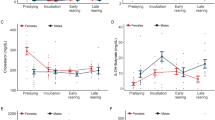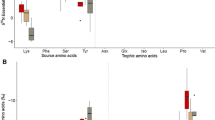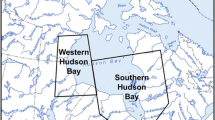Abstract
The study of variations in plasma metabolite profiles has emerged as a useful physiological tool to assess fuel deposition rates from a single blood sample. Diet may be a key factor in the study of refueling patterns in long-distance migratory birds, but the potential confounding effect of diet on the conclusions drawn from plasma metabolites has rarely been considered. Here, we assessed whether plasma metabolite levels correlate with the weekly increase in body mass of migrating Black-tailed Godwits Limosa limosa, a medium–large shorebird, feeding on two natural diets (insectivorous vs. granivorous) during the refueling period. We found that glycerol and triglycerides successfully explained the weekly natural change in body mass of Black-tailed Godwits. Although the diet type contributed to the change in body mass, all interactions between plasma metabolites and diet treatment were non-significant. Our results support the use of plasma metabolite profiling to predict body mass changes on a long-term (weekly) scale in medium–large birds.
Zusammenfassung
Plasma-Metaboliten korrelieren mit wöchentlichen Körpermasse-Änderungen bei ziehenden Uferschnepfen ( Limosa limosa ) mit unterschiedlicher Ernährung
Die Untersuchung von Unterschieden in den Profilen von Plasma-Metaboliten ist inzwischen ein nützliches physiologisches Werkzeug, um die Füllung der Energiespeicher aus einer einzigen Blutprobe abzuschätzen. Ernährung könnte ein Schlüsselfaktor sein in der Untersuchung von Mustern der Zwischenstopps für die Nahrungsaufnahme bei Langstreckenziehern, aber die möglichen Effekte der Ernährung auf die Schlussfolgerungen, die aus der Messung der Plasma-Metaboliten gezogen werden, wurde selten in Erwägung gezogen. Hier untersuchen wir, ob Plasma-Metabolitlevel mit der wöchentlichen Gewichtszunahme ziehender Uferschnepfen korrelieren, einer mittelgroßen Limikolenart, die sich auf Zwischenstopps entweder von Insekten oder von Körnern und Samen ernähren. Wir fanden, dass Plasma-Glycerin und Plasma-Triglyceride die natürliche wöchentliche Änderung im Körpergewicht von Uferschnepfen erfolgreich erklärten. Die Ernährungsweise hatte einen Einfluss auf die Änderung der Körpermasse bei Uferschnepfen, aber alle Interaktionen zwischen Plasma-Metaboliten und Ernährung waren nicht signifikant. Unsere Ergebnisse unterstützen den Einsatz des Plasma-Metabolit Profiling, um Änderungen des Körpergewichts bei mittelgroßen Vögeln in einem längeren Zeitraum (Woche) vorauszusagen.


Similar content being viewed by others
References
Albano N, Masero JA, Villegas A, Abad-Gómez JM, Sánchez-Guzmán JM (2011) Plasma metabolite levels predict bird growth rates: a field test of model predictive ability. Comp Biochem Physiol A 160:9–15
Alerstam T, Hedenström A (1998) The development of bird migration theory. J Avian Biol 29:343–369
Alerstam T, Lindström Å (1990) Optimal bird migration: the relative importance of time, energy and safety. In: Gwinnwe E (ed) Bird migration: physiology and ecophysiology. Springer, Berlin, pp 331–351
Alonso-Alvarez C, Ferrer M, Velando A (2002) The plasmatic index of body condition in yellow-legged Gulls Larus cachinnans: a food-controlled experiment. Ibis 144:147–149
Anteau MJ, Afton AD (2008) Using plasma-lipid metabolites to index changes in lipid reserves of free-living Lesser scaup (Aythya affinis). Auk 125:354–357
Battley PF, Piersma T, Dietz MW, Tang S, Dekinga A, Hulsman K (2000) Empirical evidence for differential organ reductions during trans-oceanic bird flight. Proc R Soc Lond B 267:191–195
Cerasale DJ, Guglielmo CG (2006) Dietary effects on prediction on body mass changes in birds by plasma metabolites. Auk 123:836–846
Delingat J, Dierschke V, Schmaljohann H, Mendel B, Bairlein F (2006) Daily stopovers as optimal migration strategy in a long-distance migrating passerine: the Northern wheatear Oenanthe oenanthe. Ardea 94:593–605
Dietz MW, Jenni-Eiermann S, Piersma T (2009) The use of plasma metabolites to predict weekly body-mass change in Red knots. Condor 111:88–99
Dunn EH (2001) Mass change during migration stopover: a comparison of species groups and sites. J Field Ornithol 72:419–432
Faul F, Erdfelder E, Lang AG, Buchner A (2007) G*Power 3: a flexible statistical power analysis program for the social, behavioral, and biomedical sciences. Behav Res Methods 39:175–191
Faul F, Erdfelder E, Buchner A, Lang AG (2009) Statistical power analyses using G*Power 3.1: test for correlation and regression analyses. Behav Res Methods 41:1149–1160
Guglielmo CG, O’Hara PD, Williams TD (2002) Extrinsic and intrinsic sources of variation in plasma lipid metabolites of free-living Western sandpipers (Calidris mauri). Auk 119:437–445
Guglielmo CG, Cerasale DJ, Eldermire C (2005) A field validation of plasma metabolite profiling to assess refueling performance of migratory birds. Phys Biochem Zool 78:116–125
Jenni L, Schwilch R (2001) Plasma metabolite levels indicate change in body mass in reed warblers Acrocephalus scirpaceus. Avian Sci 1:55–65
Jenni-Eiermann S, Jenni L (1994) Plasma metabolite levels predict individual body-mass changes in a small long-distance migrant, the Garden warbler. Auk 111:888–899
Jenni-Eiermann S, Jenni L (1998) What can plasma metabolites tell us about the metabolism, physiological state and condition of individual birds? An overwiew. Biol Cons Fauna 102:312–319
Lindström Å (1991) Maximum fat deposition rates in migrating birds. Ornis Scand 22:12–19
Masero JA, Santiago-Quesada F, Sánchez-Guzmán JM, Villegas A, Abad-Gómez JM, Lopes RJ, Encarnaçao V, Corbacho C, Morán R (2011) Long lengths of stay, large numbers, and trends of the black-tailed Godwit Limosa limosa in rice fields during spring migration. Bird Conserv Int 21:12–24
McWilliams SR, Guglielmo CG, Pierce B, Klaassen M (2004) Flying, fasting, and feeding in birds during migration: a nutritional and physiological ecology perspective. J Avian Biol 35:377–393
Moore FR, Gauthreaus SA Jr, Kerlinger P, Simons TR (1995) Habitat requirements during migration: important link in conservation. In: Martin TE, Finch DM (eds) Ecology and management of neotropical migratory birds. Oxford University Press, New York, pp 121–144
Newton I (2008) The migration ecology of birds. Academic Press, London
Ramenofsky M (1990) Fat storage and fat metabolism in relation to migration. In: Gwinner E (ed) Bird migration: physiology and ecophysiology. Springer, Berlin, pp 214–231
Sánchez-Guzmán JM, Moran R, Masero JA, Corbacho C, Costillo E, Villegas A, Santiago-Quesada F (2007) Identifying new buffer areas for conserving waterbirds in the Mediterranean basin: the importance of the rice fields in Extremadura, Spain. Biodiv Conserv 16:3333–3344
Santiago-Quesada F, Masero JA, Albano N, Villegas A, Sánchez-Guzmán JM (2009) Sex differences in digestive traits in sexually size-dimorphic birds: insights from an assimilation efficiency experiment on black-tailed Godwit. Comp Biochem Physiol A 152:565–568
Santiago-Quesada F, Masero JA, Estrella SM, Sánchez-Guzmán JM (2012) Persistent bimodal activity patterns in wild and captive black-tailed godwit Limosa limosa under different environmental conditions. Behav Ecol Sociobiol 66:397–405
Santiago-Quesada F, Estrella SM, Sánchez-Guzmán JM, Masero JA (2014) Why water birds forage at night: a test using black-tailed godwits Limosa limosa during migratory periods. J Avian Biol 45:406–409
Schaub M, Jenni L (2001) Variation in fuelling rates among sites, days and individuals in migrating passerine birds. Funct Ecol 15:584–594
Schaub M, Jenni L, Bairlein F (2008) Fuel stores, fuel accumulation, and the decision to depart from a migration stopover site. Behav Ecol 19:657–666
Seaman DA, Guglielmo CG, Williams TD (2005) Effects of physiological state, mass change and diet on plasma metabolite profiles in the western sandpiper Calidris mauri. J Exp Biol 208:761–769
Smith SB, McWilliams SR (2009) Dietary macronutrients affect lipid metabolites and body composition of a migratory passerine, the white-throated sparrow (Zonotrichia albicollis). Phys Biochem Zool 82:258–269
Smith SB, McWilliams SR (2010) Patterns of fuel use and storage in migrating passerines in relation to fruit resources at autumn stopover sites. Auk 127:108–118
Smith SB, McWilliams SR, Guglielmo CG (2007) Effect of diet composition on plasma metabolite profiles in a migratory songbird. Condor 109:48–58
Totzke U, Bairlein F (1998) The body mass cycle of the migratory garden warbler (Sylvia borin) is associated with changes of basal plasma metabolite levels. Comp Biochem Physiol A 121:127–133
Weber TP, Ens BJ, Houston AI (1998) Optimal avian migration: a dynamic model of fuel stores and site use. Evol Ecol 12:377–401
Williams TD, Guglielmo CG, Egeler O, Martyniuk CJ (1999) Plasma lipid metabolites provide information on mass change over several days in captive Western sandpipers. Auk 116:994–1000
Ydenberg RC, Butler RW, Lank DB, Guglielmo CG, Lemon M, Wolf N (2002) Trade-offs, condition dependence and stopover site selection by migrating sandpipers. J Avian Biol 33:47–55
Zajac RM, Cerasale DJ, Guglielmo CG (2006) The rapid response of plasma metabolites to changes in feeding rate in a small passerine Wilson’s warbler Wilsonia pusilla. J Avian Biol 37:405–408
Acknowledgments
We thank J. Schröeder for her help and collaboration with captive godwits, and three anonymous reviewers for their useful comments on the manuscript. Projects PRI A060000209 and GR10174 (Government of Extremadura and FEDER funds) and the grants AP2005-1664 (Spanish Ministry of Science and Innovation) and RE12002 (Government of Extremadura and FSE funds) provided financial support. Experimental and field work was carried out with permission, and complied with legal requirements of the regional government.
Author information
Authors and Affiliations
Corresponding author
Additional information
Communicated by L. Fusani.
Rights and permissions
About this article
Cite this article
Albano, N., Santiago-Quesada, F., Villegas, A. et al. Plasma metabolites correlate with weekly body mass changes in migrating black-tailed Godwits Limosa limosa feeding on different diets. J Ornithol 157, 201–207 (2016). https://doi.org/10.1007/s10336-015-1268-4
Received:
Revised:
Accepted:
Published:
Issue Date:
DOI: https://doi.org/10.1007/s10336-015-1268-4




